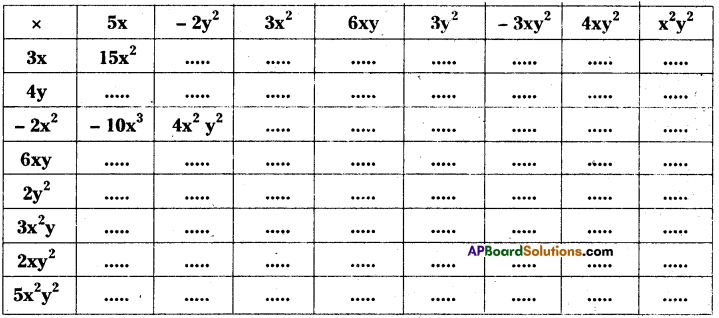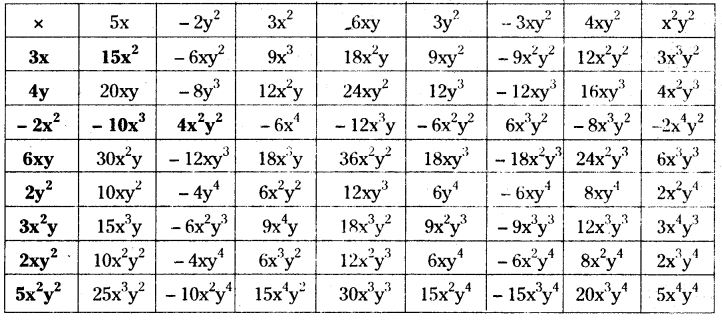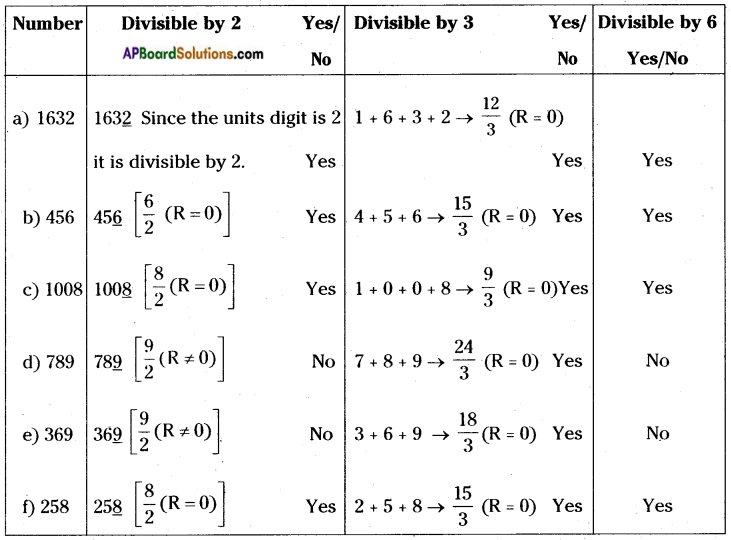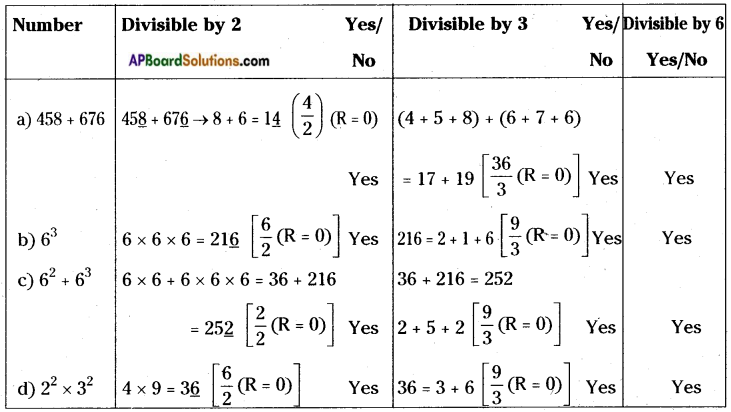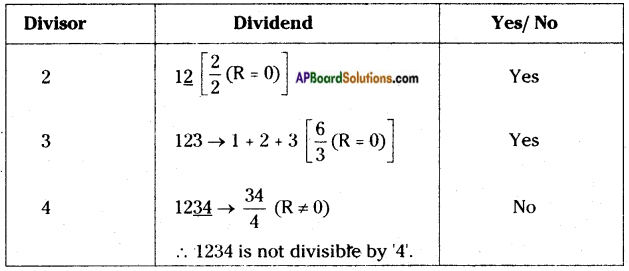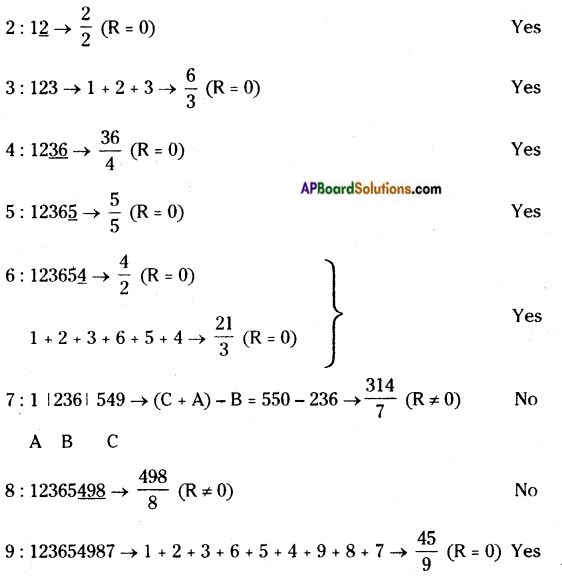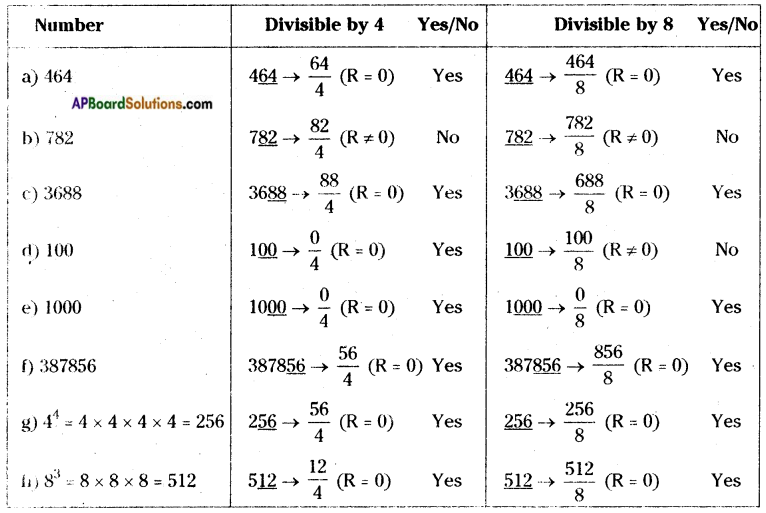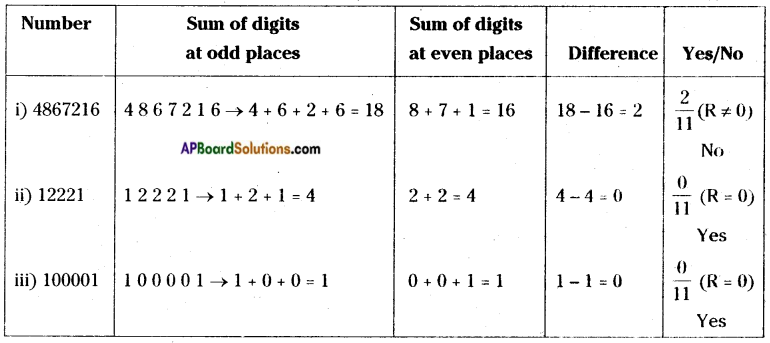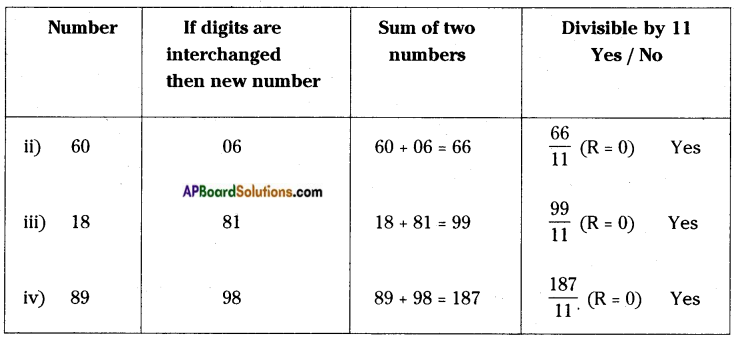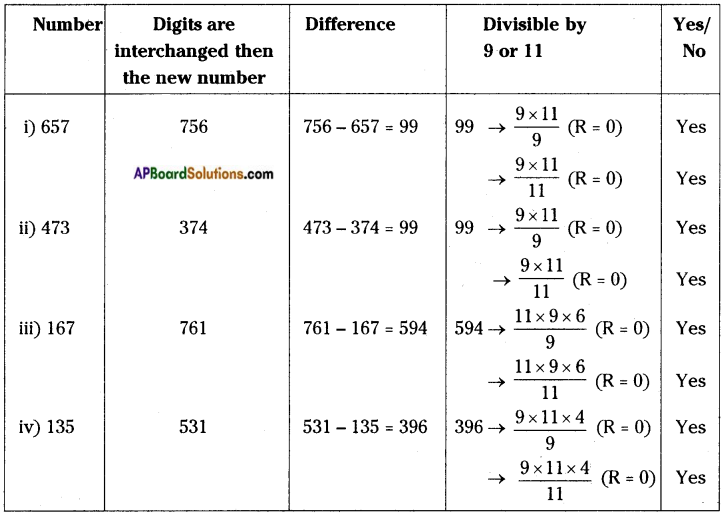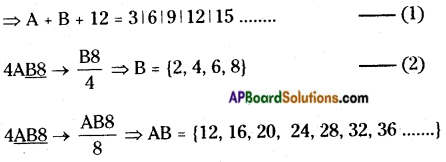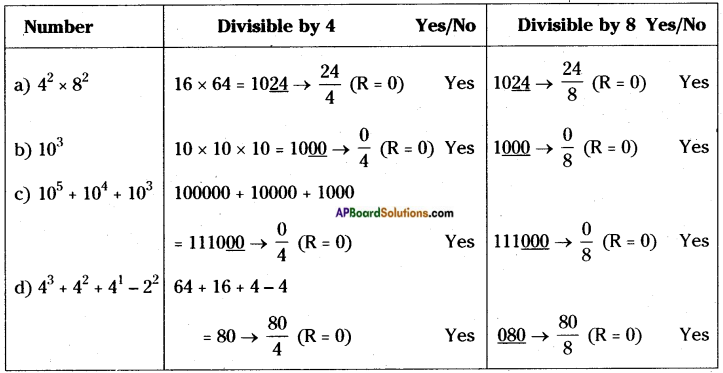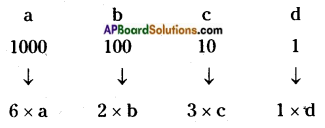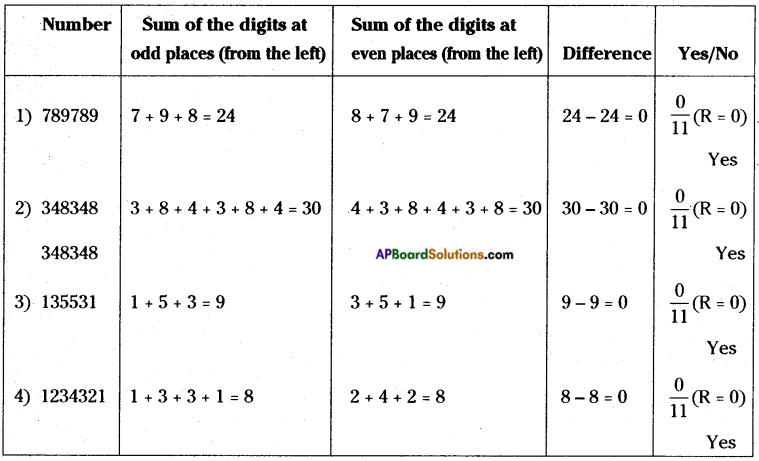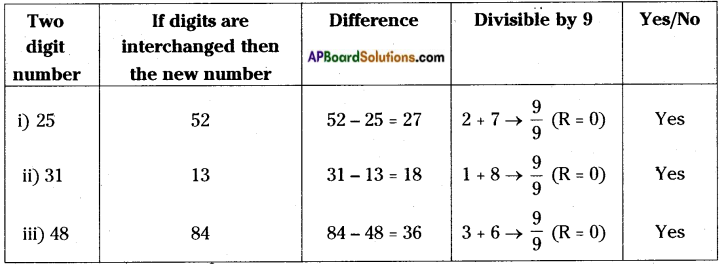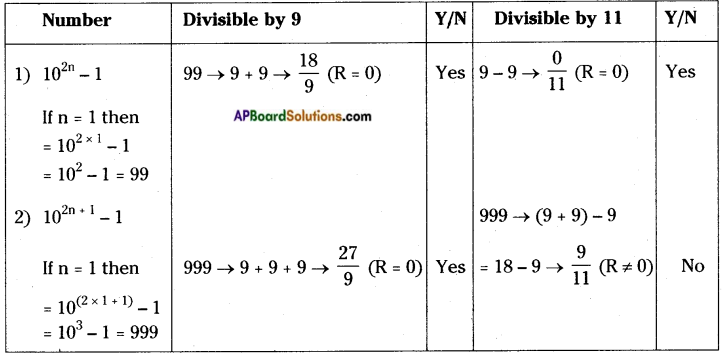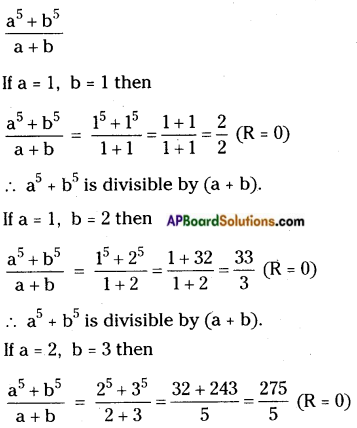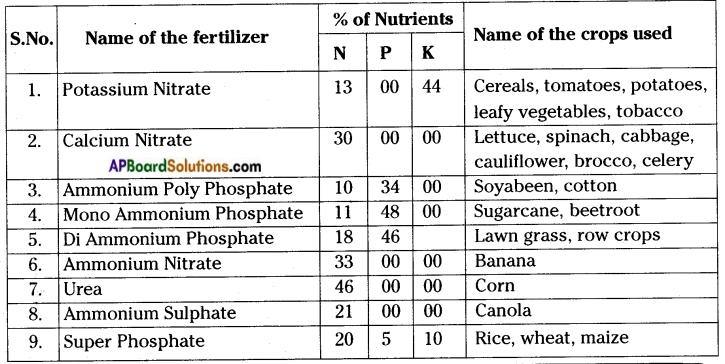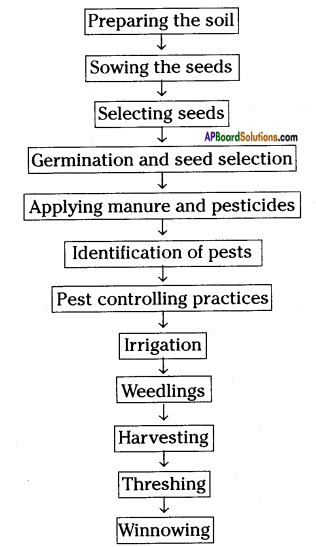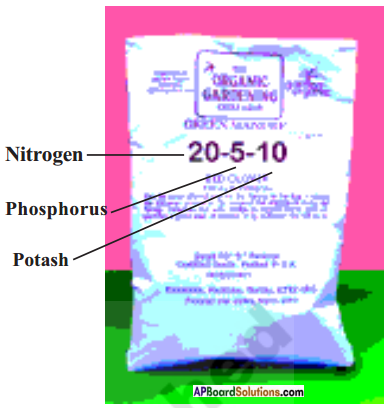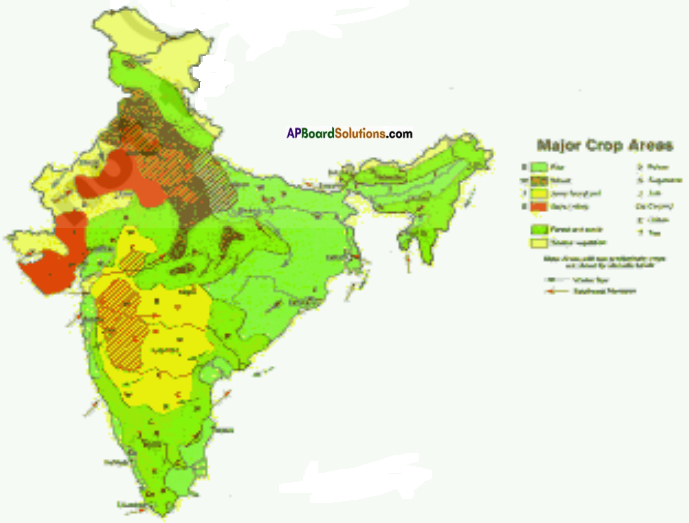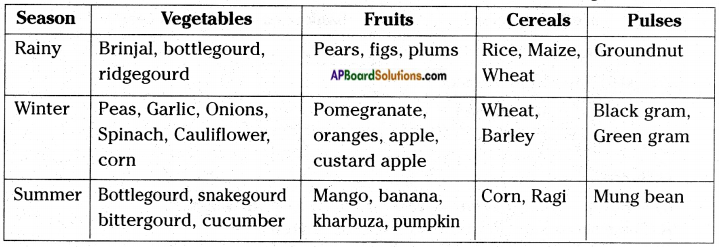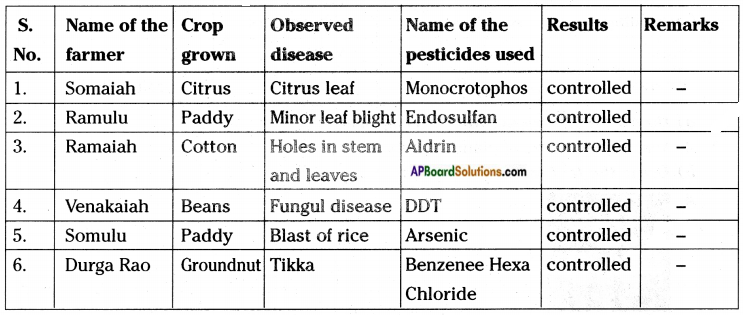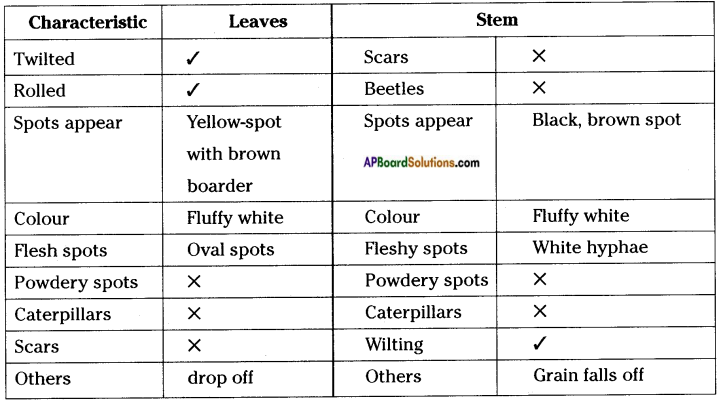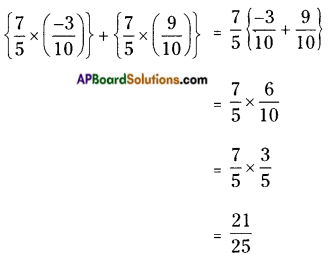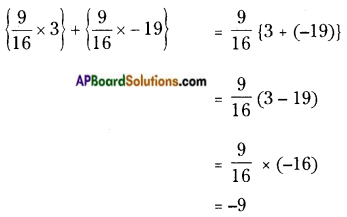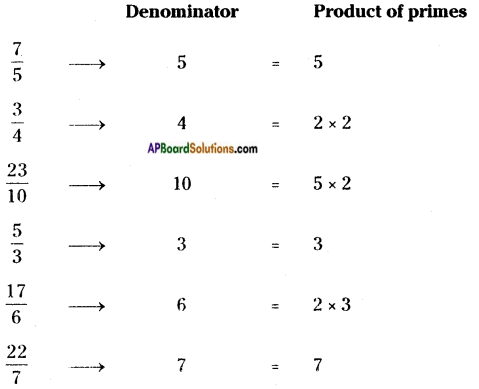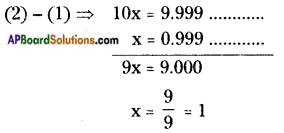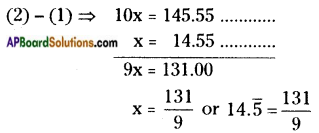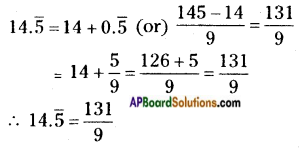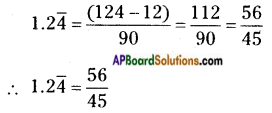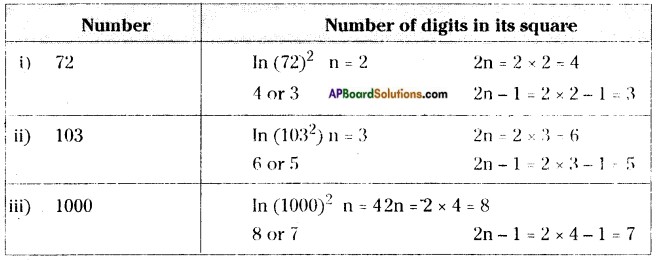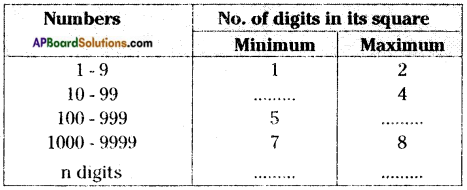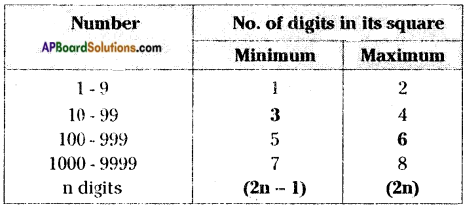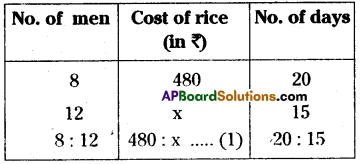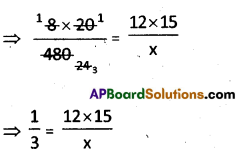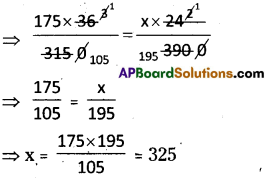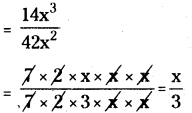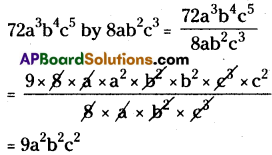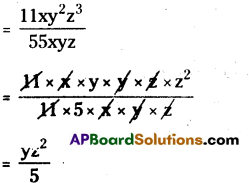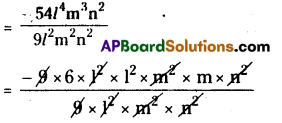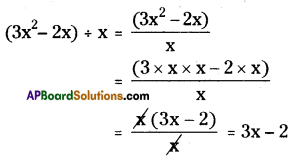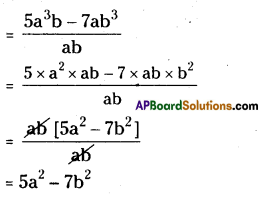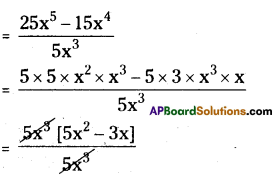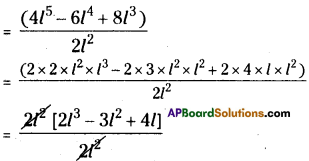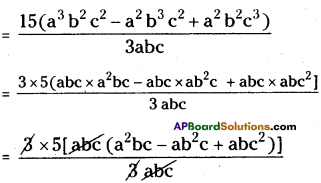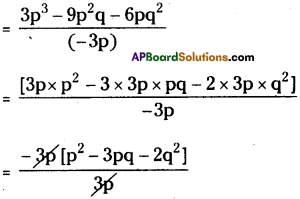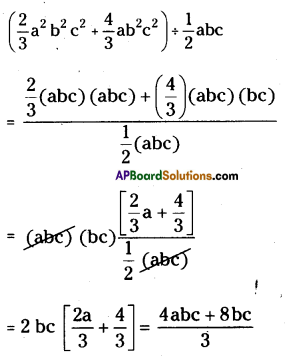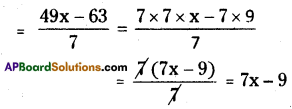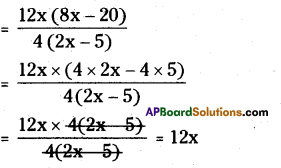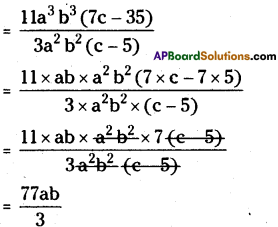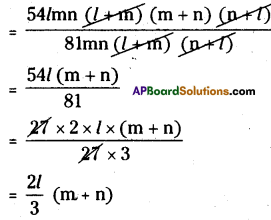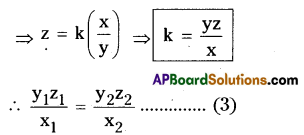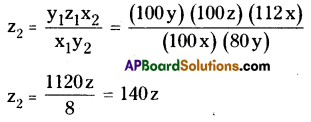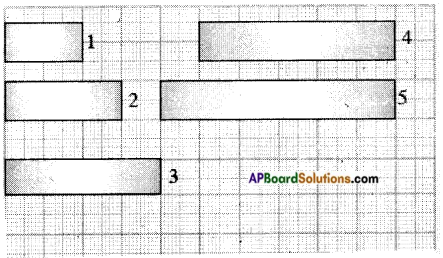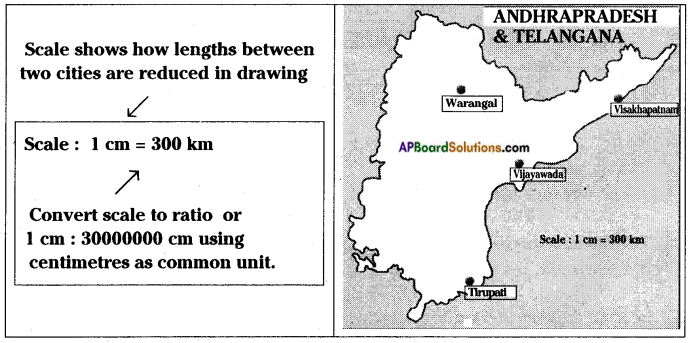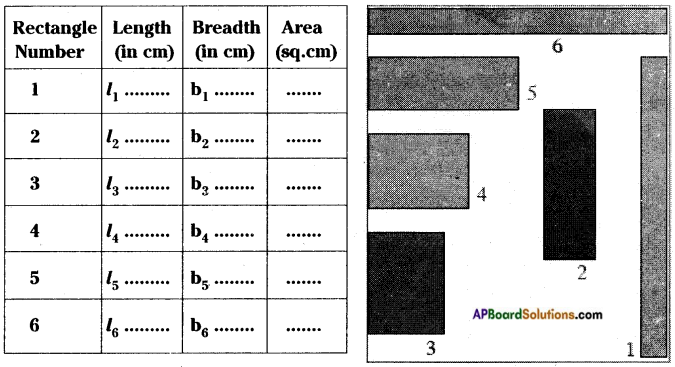AP State Syllabus AP Board 8th Class Biology Solutions Chapter 4 Reproduction in Animals Textbook Questions and Answers.
AP State Syllabus 8th Class Biology Solutions 4th Lesson Reproduction in Animals
8th Class Biology 4th Lesson Reproduction in Animals Textbook Questions and Answers
Improve Your Learning
Question 1.
Differentiate between:
a) Sexual Reproduction and Asexual Reproduction
b) Gametes and Zygote
c) External fertilization and Internal fertilization
d) Viviparous and Oviparous animals
Answer:
a) Sexual Reproduction and Asexual Reproduction:
| Sexual Reproduction | Asexual Reproduction |
| 1. Male and female gametes are formed. | 1. No production of gametes. |
| 2. Involves fusion of male and female gametes. | 2. No fusion of gametes. |
| 3. Involves two organisms. | 3. Involves a single organism. |
| 4. Offsprings have some characters from male parent and other from female parent. Some characters may not be present in either of the parents. | 4. Produces offsprings that are identical to the parent. |
![]()
b) Gametes and Zygote:
- Millions of male gametes (sperms) are produced by the testes. These are microscopic and single celled. Sperm has a head, a middle piece and a tail.
Ovary produces female gaffietes called ova. It is a single cell, (haploid) - The fusion of male and female garnet is called fertilization. The result of fertilization is the formation of a zygote. Zygote is a diploid cell. This develops mitorically and forms into an embryo, which further develops into a baby.
c) External fertilization and Internal fertilization:
The process of fertilization that occurs outside of an organism is called External fertilization.
E.g. Frog, Fish, Star fish, etc.
The process of fertilization that takes place inside the body of females is called Internal fertilization. E.g. Animals, Human beings.
d) Viviparous and Oviparous animals:
Animals which give birth to their offsprings are called Viviparous animals.
E.g. Animals, human beings.
Animals which lay eggs are called Oviparous animals.
E.g. Hen, duck, pigeon, etc.
Question 2.
Compare the reproduction in Hydra and Amoeba. Note down the differences in your notebook.
Answer:
Comparison:
Asexual Reproduction takes place in Hydra and Amoeba.
| Hydra | Amoeba |
| 1. Multicellular organism. | 1. Unicellular organism. |
| 2. Nucleus is absent. | 2. Nucleus is present. |
| 3. Buds are formed on the body surface. | 3. A constriction is formed in the middle of the nucleus. |
| 4. The bud increases in size and develops tentacles. | 4. The constriction deepens divides the nucleus into two nuclei. |
| 5. It grows in size. | 5. A constriction is formed on the body wall of Amoeba in the middle. |
| 6. This bud separates from the parent Hydra and lives independently. | 6. The constriction deepens and divides the body of amoeba into two individuals (daughter amoebae). |
![]()
Question 3.
Why do fish and frog lay more number of eggs whereas cow and human beings usually give birth to only one at a time?
Answer:
- Fish and frog lay many eggs to increase chance of survival of the offspring and the continuation or their generation.
- They do not take care of their young ones making them prone to predators and may even be washed away by the water force.
- Thus the more eggs produced, the greater the chances that some will grow to maturation.
- Female frog and fish release their eggs in the water and male animals release their sperms in the water. As fertilization takes place in the water it is external ferlitization. There is no safety for the fertilized eggs in the water so these animals lay more number of eggs.
- Whereas cow and human beings usually give birth to only one at a time and the internal fertilization takes place in these animals. There is safety for the embryo (the offspring) in the mother’s womb until it’s birth.
Question 4.
Can animals produce offsprings even without formation of zygotes, how? Explain with suitables example.
Answer:
- Besides Asexual and Sexual Reprodution, there is other mode of reproduction called cloning.
- Cloning is the production of an exact copy of a cell, any other living part, or a complete organism.
- Cloning of an animal was successfully performed for the first time by Ian Wilmut and his colleagues at the Roslin Institute in Edinburgh, Scotland.
- They successfully cloned a sheep named Dolly. Dolly was born on 5th July 1996 and was the first mammal to be cloned.

- During the process of cloning dolly, a cell was collected from the mammary gland of a female Finn Dorset Sheep.
- Simultaneously, an egg was obtained from Scottish black face ewe.
- The nucleus was removed from the egg. Then the nucleus of the mammary gland cell from the Finn Dorset sheep was inserted into the egg of the Scottish black face ewe whose nucleus had been removed.
- Thus the egg produced was implanted into the Scottish black face ewe. Development of this egg followed normally and finally Dolly was born.
- Though Dolly was given birth by the Scottish black face ewe, it was found to be absolutely identified to the Finn Dorset sheep, from which the nucleus was taken.
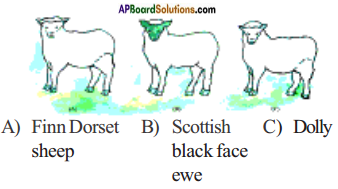
- Since the nucleus from the egg of the Scottish black face ewe was removed, Dolly did not show any character of the Scottish black face ewe.
Dolly was a healthy clone of the Finn Dorset sheep and produced several off-springs of her own through normal sexual means.
![]()
Question 5.
How can you identify the animal is viviparous or oviparous?
Answer:
- Animals giving birth to young ones have epidermal hair on their skin and external ears. These animals are called viviparous animals.
E.g. Animals, human beings, etc. - The animals that lay eggs do not have epidermal hair or external ears. These animals are called oviparous animals.
E.g. Hen, Duck, Pigeon, Parrot, etc.
Question 6.
Who am I?
a) I am formed by the fusion of male and female gametes.
Answer:
Zygote: Zygote is formed by the fusion of male and female gametes. This process is
called fertilization.
b) I am a gamete that has a tail and travel to fuse with female gametes.
Answer:
Male garnets or sperm or spermatozoa:
The structure of sperm has a head, a middle piece and a tail.
c) I am a fully developed embryo inside a mother’s body.
Answer:
Offspring or baby:
The zygote divides repeatedly to give rise a ball of cells. The cells then begin to form groups that develop into tissues and organs in the body. This developing structure is termed as an Embryo.
The embryo gets embedded in the wall of the uterus for further development. It develops in the uterus. It gradually develops body parts such as hands, legs, head, eyes, ears etc. From 3 months (12 weeks) of pregnancy the embryo is called FOETUS – After the completion of this period (about 270 – 280 days) a baby (offspring) is born. This is called gestation period.
Question 7.
State the reason why most of the terrestrial animals’, fertilization takes place internally.
Answer:
- In animals like insects, reptiles, birds and mammals, the male animals deposit the sperms inside the body of the female animals, where fertilization occurs. This is called Internal Fertilization. This is most common in terrestrial animals.
- In majority of the animals, sexes are separate and male and female animals are distinct. This is called sexual dimorphism and animals are said to be unisexual.
- The external features by which the males and females can be distinguished are called Secondary sexual characters.
- There are some animals in which male and female sex organs are present in the same animal. This is called Hermaphroditism and such animals are called Hermaphrodites or Bisexual.
- Hermaphroditism is seen in some of the members of protozoa, Coelenterata, Platy- helminthes, Nematoda, Annelida and mollusca. In these animals sperm and ova are formed in the same animal. However self fertilization is prevented by several methods.
![]()
Question 8.
Observe the following figures and write the functions of them.

Answer:
a) Testes:
Testes are the male reproductive organs and produce male gametes known as sperms or spermatozoa. Testes are egg shaped. It is connected with a pair of seminal ducts through which sperms travel and ejaculate out with the help of penis.
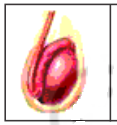
b) Female Reproductive system. Oviduct or fallopian tube connected with ovary. Female reproductive system contains a pair ovaries, oviducts and also called fallopian tubes and uterus.
The ovary produces female gametes called ova or eggs. In human beings, a single matured egg is released into the oviduct by one of the ovaries every month.

The ovum which is a single cell released from ovary and enters into a tube called Fallopian Tube. The end of the tube is like a funnel with several finger like structures and is also ciliated. The movement of cilia help the movement of ovum through the fallopian tube into uterus.
c) Sperm:
Human sperms are minute, microscopic and motile they have a oval head, a neck, a middle piece and a long tail.
Head consists of a large haploid nucleus. Acrosome is present in the head, which helps in fertilization.
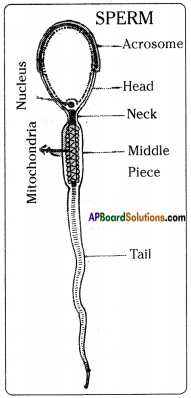
The neck is short middle piece has several mitochondria which produce energy required for the movements of sperms. Tail piece helps in the swimming of sperm to reach the ovum during fertilization.
d) Fusion of ovum and sperm:
(Fertilization) Fertilization is of internal type. Sperm reaches the ovum in the fallopian tube. Sperm nucleus enters the ovum which is haploid.
When sperm enters the ovum the membranes of ovum becomes thicken. So that another sperm can not penetrate the ovum. This prevents double fertilization of the ovum. During fertilization, the sperm and the ovum fuse to form a zygote.

This type of internal fertilization occurs in different organisms like insects, snakes, lizards, birds and mammals etc.
![]()
Question 9.
a) By taking help of given words label the following life cycle, (eggs, adult, pupa, larva)
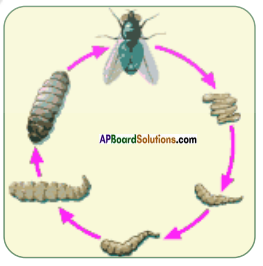
Answer:
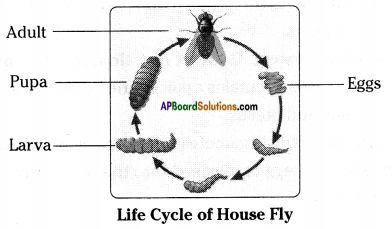
b) Explain the process of metamorphosis in housefly by taking help from in the given diagram.

Answer:
Metamorphosis in the house fly: A female housefly at a time lays about 120 to 160 eggs. The eggs are laid in garbage, on dung heaps, or on a decaying animal and vegetable matter. The life history consists of 1) egg 2) larva 3) pupa and 4) adult stages. Egg: The egg is white and cylindrical on one side. It has two ribbon like longitudinal thickenings. They hatch in about 24 hours into larva.
Larva: The larva is known as a Maggot. It is white in colour. The baby of the larva has 13 segments. It has a mouth and feeds on organic matter.
Pupa: The fully grown larva moves to a dry place in the dung and changes to a pupa. The pupa is dark brown and barrel shaped. In a week, the pupa changes into an adult or imago.
Houseflies spread, germs that cause diseases like typhoid, cholera, amoebic dysentery, tuberculosis. Our food should be kept covered from houseflies. The surroundings should be clean without garbage and dung heaps. Insecticides can be used to kill the house flies.
![]()
Question 10.
Match the following.
Group – A Group – B
1. Oviparous ( ) A) Tadpole to adult
2. Metamorphosis ( ) B) Birds
3. Embryo ( ) C) Fertilisation outside the body
4. External fertilization ( ) D) Developed Zygote
Answer:
1) B
2) A
3) D
4) C
Question 11.
What would happen if all the organisms stop the process of reproduction?
Answer:
- Without reproduction living organisms would not survive long.
- Different species of living organisms die due to various reasons.
E.g. Old age, diseases, accidents, etc. - Imagine the death of members of a species continues and new individuals of that species are not added.
- A stage will come when that species will disappear.
- To ensure the continuity of the species reproduction is important.
- Depending on the available conditions in a community, different species will reproduce continuously and increase their numbers.
- Reproduction in a species will therefore:
a) Replace those species that die and
b) Allow an increase in total numbers of the species under suitable conditions.
Question 12.
Kavita found a tadpole in a pond. She collected it carefully and put it in an aquarium supposing it as a fish. After some days what did she find and why?
Answer:
- The larva that emerges from the eggs, known as tadpole, have oval bodies and long, vertically flattened tail and are fully aquatic.
- Tadpole lack eyelids and have cartilaginous skeleton. They take respiration through external gills, later it develops internal gills. It looks like a fish at this stage completely. The vertically flattened tails use for swimming.
- Tadpole lack true teeth, but the jaws two elongated parallel rows of small structures called keradonts in their upper jaw and three rows of keradonts in the lower jaw as same as the fish has.
- Tadpole are typically herbivorous, feeding mostly on algae, including diatoms, filtered the water through the gills.
- The tadpoles may be as short as a week during metamorphosis.
![]()
Question 13.
Collect information from your library or from other sources like internet and discuss the life cycle of Honeybees in the symposium at your school.
Answer:
In the life cycle of butterfly there are four stages.
- Egg
- Larva
- Pupa
- Adult.
The cycle of changes that takes place from egg to adult is called metamorphosis.
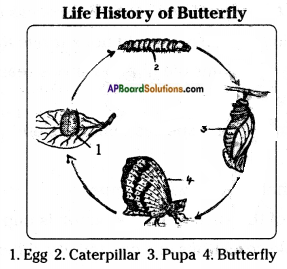
1) Egg: The egg is the first stage in the butterfly. They are very small and round. The female butterfly lays eggs on or near the plants.
2) Larva: The larva hatches from the egg. Butterfly larva are usually called Caterpillar. Caterpillars spend most of their time eating. Butterfly do all their growing when they are caterpillars, and food gives them the energy and body building materials they need. A caterpillar’s exoskeleton can’t stretch or grow, so the caterpillar sheds its skin or molts, several times as it grows.
3) Pupa: When the caterpillar has finished growing, it forms from the outside, the pupa looks as if it’s resting. But inside, every part of the caterpillar is changing. Most of it’s organs and other body parts like head, thorax and abdomen, 3 pairs of legs, 2 pairs of wings, a pair of compound eyes, the antennae, a proboscis etc. are formed. Butterfly pupa are called chrysalises.
4) Adult: When the pupa has finished changing, it molts one last time and emerges as an adult butterfly. The adult emerges with its wings folded up against its body. The adult is the stage when butterfly mate the reproduce. Females lay their eggs on plants or other surfaces and the cycle starts all over again.
![]()
Question 14.
Sketch the diagrams of male and female reproductory systems.
Answer:
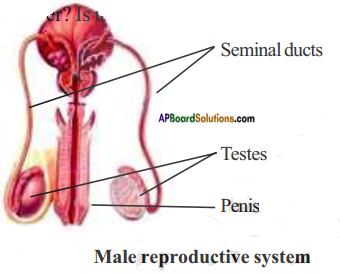
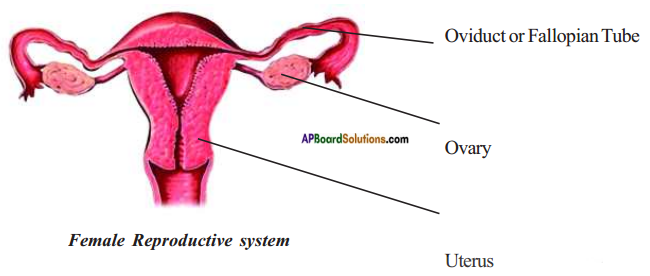
Question 15.
Draw labelled diagram of life history of frog and identify forms are herbivores.
Answer:
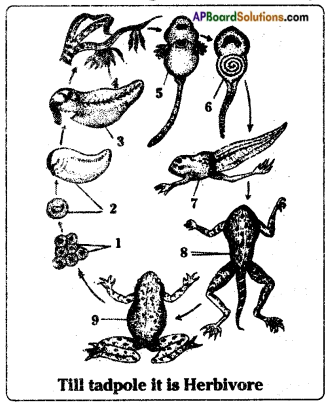
Parts:
- Egg
- Embryo before hatching
- Hatched tadpole
- Tadpole attached to water plant
- Tadpole with external gills
- Developing tadpole
- Tadpole with fore and hind limbs
- Tadpole changing into frog
- Frog
![]()
Question 16.
How would you appreciate Ritwik’s work when he kept back the pigeon squab in the ventilator? If you were in Ritwik’s place what would you do?
Answer:
- If i were in Ritwik’s place, I would like to show kindness towards the pigeon squab by keeping back the pigeon squab in the ventilator. He took great care towards it.
- Research their needs and do what makes them happiest.
- Check that we are not inadvertently supporting animal cruelty, which are in our surroundings.
- Leave room for wild life habitates in the own yard by providing birds with feeders and bird bath.
- Create a clean environment for the birds and animals.
- Cut the usage of plastic so they can not be danger to wild life.
- Appreciate wild life and learn more about it but do not approach them or attempt to resque them.
- Never tolerate birds or animal cruelty. Report suspected cruelty to the authorities.
- In still compasion in the children by demonstrating kindness and using positive training methods for the pets.
- Keep them vaccinations’ current and visit veterinarian regularly.
Project work
Note: This project work needs patience and carefulness. Teachers should be cautious while doing this project. Care should be taken at the time of collection of eggs of frogs. From a nearby pond or slow flowing streams. If eggs are not available, you need not to worry. You can start your project after collecting Tadpoles.
To conduct this project you require:
- Wide mouth transparent bottle / tub
- Transparent glass
- Dropper
- Petridish
- Some pebbles
- Magnifying lens
Answer:
Step -1: Go to a nearby pond or a slow flowing stream where usually sewage stagnates during rainy season. Collect few eggs of a frog with the help of wide mouthed bottle as shown in the figure. While collecting eggs, take care that the clusters of eggs are not disturbed and isolated.
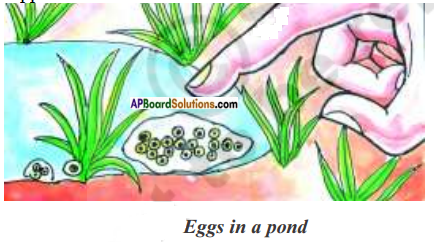
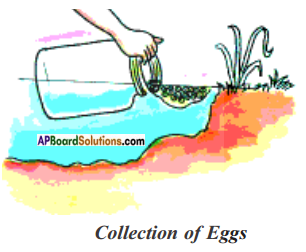
Step – 2: After collecting eggs, take a tub of 15 cm depth and a radius of 8-10 cms. Transfer the eggs along with the weeds and algae that you have collected from the pond into the tub. Carefully observe the eggs. You will find a blackish part in the middle of the eggs. That is the embryo of the frog.
Step – 3: Observe the tub daily and note down the changes in your observation book. Draw diagrams after observing for atleast once in three days.
CHANGES TAKES PLACE FROM EGG TO ADULT IN FROG
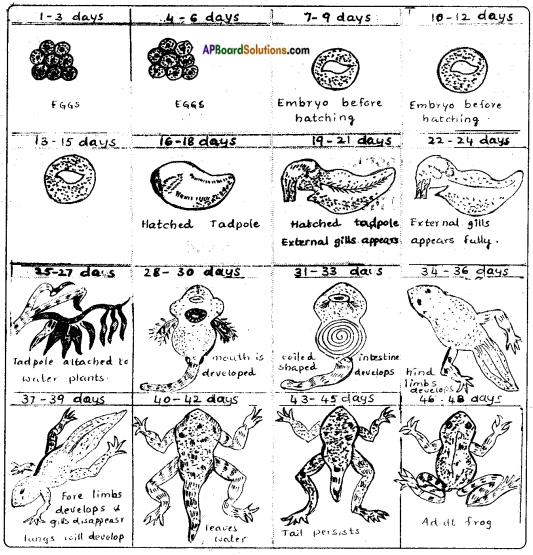
Step – 4:

Step – 5:
Try to answer these questions after your observation.
1. How many days did it take for the eggs to hatch?
Answer:
It takes 10 to 15 days for the eggs to hatch.
2. How does the tadpole look like?
Answer:
The tadpole looks like a fish.
3. When did you find gill slits in a tadpole?
Answer:
19 to 22 days.
4. On which dates did you observe?
Answer:
Heart: 28th to 30th dates.
Intestine: 31st to 3rd (31 to 33 days)
Bones: 4th to 6th (34 to 36 days)
Rectum: 31st to 3rd (31 to 33 days)
Hindlimbs: 4th to 6th (34 to 36 days)
Forelimbs: 7th to 9th (37 to 39 days)
![]()
Step – 6:

1. When did gill slits disappear?
Answer:
37 to 39 days.
2. When did the tail completely disappear?
Answer:
42 to 44 days.
3. How many days did it take for a tadpole to transform into an adult frog?
Answer:
It takes 45 to 46 days to take for a tadpole to transform into an adult frog.
8th Class Biology 4th Lesson Reproduction in Animals InText Questions and Answers
Question 1.
Do all eggs hatch into nestlings?
Answer:
Yes, all eggs hatch into nestlings.
Question 2.
Can there be pigeons if there were no eggs?
Answer:
If there were no eggs there can not be no pigeons.
Question 3.
Can there be eggs if there were no pigeons?
Answer:
If there were no pigeons, there cannot be no eggs.
Question 4.
Do all animals lay eggs?
Answer:
All animals do not lay eggs.
Question 5.
Are there any animals that give birth to young ones?
Answer:
Animals like cat, dog etc., give birth to their young ones.
Question 6.
How can we identify which animals lay eggs and which give birth to young ones?
Answer:
Animals that lay eggs do not have epidermal hair or external ears.
E.g. Crow, Pigeon, Parrot etc.
Animals giving birth to young ones have epidermal hair on their skin and external ears. E.g. Cow, Buffalo, Dog, Cat etc.
![]()
Question 7.
Are there any patterns in nature that give clues to modes of reproduction?
Answer:
There are two types of reproduction.
- Asexual reproduction and
- Sexual reproduction.
Question 8.
Names of some animals are listed below. Observe carefully and fill the table. Deer, Leopard, Pig, Fish, Buffalo, Giraffe, Frog, Sparrow, Lizard, Crow, Snake, Elephant, Cat.
Answer:
| Animals that have external ears | Animals that do not have external ears |
| Deer | Fish |
| Leopard | Frog |
| Pig | Sparrow |
| Buffalo | Lizard |
| Giraffe | Crow |
| Elephant | Snake |
| Cat | |
You can also add some more names of animals you know to this table.
Question 9.
Think how animals could hear without external ears?
Answer:
Though the animals do not have ears to hear, they can sense the surrounding by its body.
Question 10.
Read the names of animals given below and try to fill the table given below.
Cow, Rat, Crow, Pig, Fox, Hen, Camel, Duck, Frog, Elephant, Buffalo, Pigeon, Cat, Peacock, Lizard. You can also add a few more animals to this list.
Answer:
| Name of Animals | Presence of external ears (Yes/No) | Presence of epidermal hairs on the skin/Feathers on their wings |
| Cow | Yes | Epidermal hair |
| Rat | Yes | Epidermal hair |
| Crow | No | Feathers on their wings |
| Pig | Yes | Epidermal hair |
| Fox | Yes | Epidermal hair |
| Hen | No | Feathers on their wings |
| Camel | Yes | Epidermal hair |
| Duck | No | Feathers on their wings |
| Frog | No | No hair, no feathers |
| Elephant | Yes | No hair |
| Buffalo | Yes | Epidermal hair |
| Pigeon | No | Feathers on their wings |
| Cat | Yes | Epidermal hair |
| Peacock | No | Feathers on their wings |
| Lizard | No | No feathers, no wings. |
8th Class Biology 4th Lesson Reproduction in Animals Activities
Activity – 1
![]()
Question 1.
Draw the diagram of Hydra. Compare it with the figure below recall what you have observed in the first slide ?
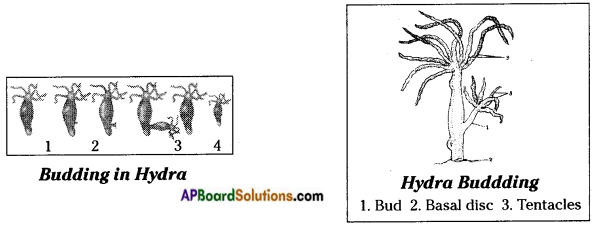
Compare slide 1 & 2 to observe which part of it’s body develops a swelling?
Answer:
The body wall develops swelling. Observe all the remaining slides.
a) What have you observed in slide/picture 1, 2 and 3?
Answer:
Picture 1, 2 the body surface of hydra has smooth surface.
Picture 3, a swelling is formed on it’s body surface.
b) What is the main difference between slide 1 and 2 as well as 3 and 4?
Answer:
Slide 1 and 2 Hydra body is smooth.
Slide. 3, a swelling is formed. Swelling increases in size, tentacles are formed which is called bud.
Slide 4, the bud is cut off and separated from parent Hydra and can live individually.
c) What does swelling (bulge) develop into?
Answer:
The swelling develops into a bud.
Activity – 2
Question 2.
Observe the given diagram carefully and fill the following table:
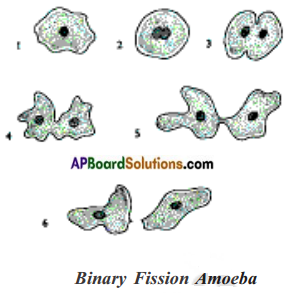
i)
| Changes in the Nucleus/Body structure | |
| 1st diagram | Nucleus is round. |
| 2nd diagram | Constriction in the centre of nucleus. |
| 3rd diagram | Nucleus divides into two daughter nuclei. On the centre of the body surface a constriction is formed. |
| 4th diagram | The constriction deepens. |
| 5th diagram | The constriction still deepens and ready to cut into two parts. |
| 6th diagram | Two daughter amoebae are formed. |
ii) How many amoebae are formed at the end ?
Answer:
Two amoebae are formed at the end.
Male flower – its parts:
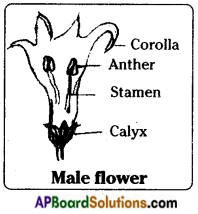
- Calyx (sepals)
- Corolla (Petals)
- Androecium (stamen)(male part)
- Pollen grain (male gametes)
Female Flower – Its parts.
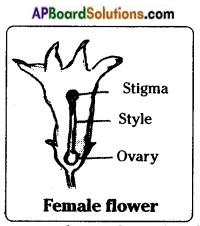
- Calyx (Sepals)
- Corolla (Petals)
- Gynoecium (Ovary) female part
- Ovules (Future seeds)
1) What would happen if fusion of sperm and ova doesn’t takes place?
Answer:
If fusion of sperm and ova doesn’t takes place fertilization would not happen.
2) Why animals give birth to their babies?
Answer:
To continue their species on the earth.
3) What happens if each couple give birth to more than two babies?
Answer:
The population increases.
4) Is it necessary to control population?
Answer:
The rapidly increasing population is posing a number of problems as our resources in nature do not increase proportionately. On the other hand they diminish. So it is necessary to control population.
![]()
Activity – 3
Question 3.
Observation of resemblance in Parents & Children.
Table given below will help you to note the similar and dissimilar. Fill in the table.
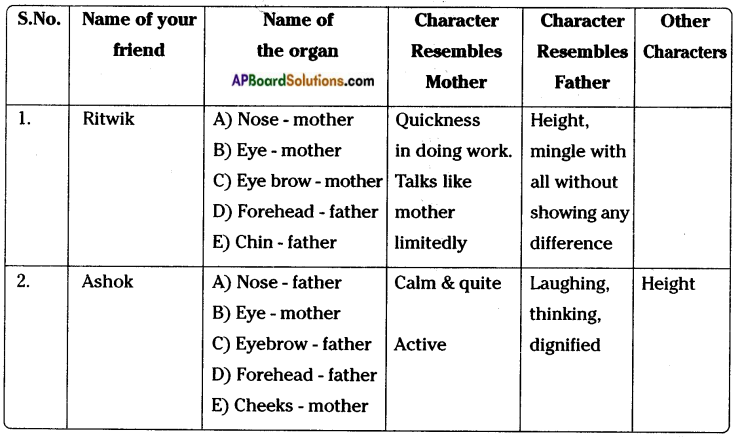
You can ask your teacher and know why sometimes no characters match with your father or mother.
Answer:
- The ability of an organism to produce a new generation of individuals of the same species is called reproduction.
- That means the characteristics of parental organisms are being transferred to their next generation in the process of reproduction.
- It involves the transmission of genetic material (chromosomes) from the parental generation to the next generation.
- In some methods of reproduction the genetic material of the parent and the offspring next generation will be exactly same.
- Whereas in some methods the characters from two parents (male and female) recombine to form a new individual.
- In this process some characters of one parent and remaining characters from the other parent are seen in the offsprings. Some characters will be new which are not seen in either of the parents.
- This happens because of chromosome recombination. The process of reproduction ensures continuation of race and the perpetuation of characteristics of the species and particularly the parental organisms.
